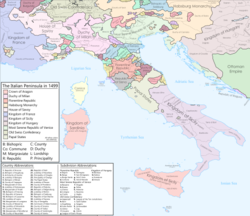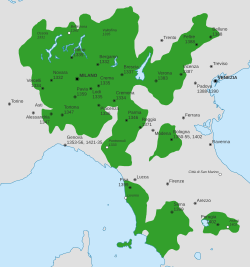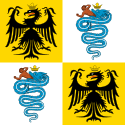
Back دوقية ميلانو Arabic Milan hersoqluğu Azerbaijani میلان دوکلیغی AZB Міланскае герцагства Byelorussian Миланско херцогство Bulgarian Dugelezh Milano Breton Ducat de Milà Catalan Milánské vévodství Czech Dugiaeth Milan Welsh Hertugdømmet Milano Danish
Duchy of Milan | |||||||||||||||
|---|---|---|---|---|---|---|---|---|---|---|---|---|---|---|---|
| 1395–1447 1450–1796 | |||||||||||||||
 Duchy of Milan in 1499 | |||||||||||||||
 The Duchy of Milan in its period of greatest expansion, between the end of the 14th century and the beginning of the 15th century. | |||||||||||||||
| Capital | Milan | ||||||||||||||
| Common languages | Lombard Italian | ||||||||||||||
| Religion | Roman Catholicism | ||||||||||||||
| Demonym(s) | Milanese | ||||||||||||||
| Government | Princely hereditary monarchy | ||||||||||||||
| Duke | |||||||||||||||
• 1395–1402 | Gian Galeazzo Visconti (first) | ||||||||||||||
• 1792–1796 | Francis II (last) | ||||||||||||||
| Historical era | Early modern | ||||||||||||||
• Imperial diploma of Wenceslaus of Bohemia | 1 May 1395 | ||||||||||||||
| 1447–1450 | |||||||||||||||
• French occupation | 1499–1512, 1515–1522 and 1524–1525 | ||||||||||||||
• Protectorate of the Swiss Confederacy | 1512–1515 | ||||||||||||||
• Habsburg rule | 1535–1796 | ||||||||||||||
• Spanish rule | 1556–1707 | ||||||||||||||
• Austrian rule | 1707–1796 | ||||||||||||||
• Annexation to the Transpadane Republic | 15 November 1796 | ||||||||||||||
| Population | |||||||||||||||
• Estimate | 750,000 in the 17th century | ||||||||||||||
| Currency | Milanese scudo, lira and soldo | ||||||||||||||
| |||||||||||||||
| Today part of | Italy Switzerland | ||||||||||||||
The Duchy of Milan (Italian: Ducato di Milano; Lombard: Ducaa de Milan) was a state in Northern Italy, created in 1395 by Gian Galeazzo Visconti, then the lord of Milan, and a member of the important Visconti family, which had been ruling the city since 1277.[1][2] At that time, it included twenty-six towns and the wide rural area of the middle Padan Plain east of the hills of Montferrat. During much of its existence, it was wedged between Savoy to the west, Republic of Venice to the east, the Swiss Confederacy to the north, and separated from the Mediterranean by Republic of Genoa to the south. The duchy was at its largest at the beginning of the 15th century, at which time it included almost all of what is now Lombardy and parts of what are now Piedmont, Veneto, Tuscany, and Emilia-Romagna.[2]
Under the House of Sforza, Milan experienced a period of great prosperity with the introduction of the silk industry, becoming one of the wealthiest states during the Renaissance.[3] From the late 15th century, the Duchy of Milan was contested between the forces of the Habsburg Monarchy and the Kingdom of France. It was ruled by Habsburg Spain from 1556 and it passed to Habsburg Austria in 1707 during the War of the Spanish Succession as a vacant Imperial fief.[4] The duchy remained an Austrian possession until 1796 when a French army under Napoleon Bonaparte conquered it, and it ceased to exist a year later as a result of the Treaty of Campo Formio, when Austria ceded it to the new Cisalpine Republic.[5]
After the defeat of Napoleon, the Congress of Vienna of 1815 restored many other states which he had destroyed but not the Duchy of Milan. Instead, its former territory became part of the Kingdom of Lombardy–Venetia, with the Emperor of Austria as its king. In 1859, Lombardy was ceded to the Kingdom of Piedmont-Sardinia, which became the Kingdom of Italy in 1861.
- ^ Black (2009), pp. 68–72
- ^ a b "::: Storia di Milano ::: dal 1201 al 1225". www.storiadimilano.it. Retrieved 1 July 2020.
- ^ "Milan – History". Encyclopedia Britannica. Retrieved 17 December 2020.
- ^ "Storia di Milano ::: dal 1701 al 1725". www.storiadimilano.it. Retrieved 1 July 2020.
- ^ "Storia di Milano ::: dal 1776 al 1800". www.storiadimilano.it. Retrieved 1 July 2020.

